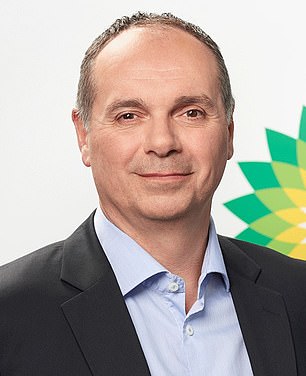Australian biofuel plant holds key to BP’s renewable energy future
A new biofuel plant in Australia has been at the forefront of BP’s efforts to go green under former boss Bernard Looney.
BP Australia boss Frederic Baudry has described the country as the “poster child” of the FTSE 100 giant’s highly ambitious global energy transition strategy.
So what happens to the Kwinana plant, south of Perth, after Looney’s departure last week – because he failed to disclose personal relationships with staff – will say a lot about BP’s future under new leadership.
For 65 years the site provided a steady source of employment and fuel for the generations who lived in this small industrial spur in Western Australia.
But as planes were grounded and cars sat idle in driveways during the Covid-19 pandemic, demand for fuel collapsed, further squeezing profit margins.
Biofuel plant: BP’s Kwinana plant, south of Perth, is intended to produce sustainable aviation fuel from raw materials such as used cooking oil or household oil.
BP closed the plant, laid off 600 workers and turned the site into an import terminal to ship cheaper fuel from abroad.
Two years later, the site is about to be repurposed again, so that the oil giant can make the switch from hydrocarbons to sustainable energy.
It is intended for a new generation of fuel refineries, one that makes sustainable jet fuel from raw materials such as used cooking oil or household waste, and renewable diesel using vegetable oils, animal fats and other biowaste products.
With construction expected to start next year, BP hopes this will be the first global biofuel project to power planes, trucks and cars.
If all goes according to plan – and that’s a big ask – BP expects to be producing hydrogen from 2026 and on a sufficient scale to start exporting it by the end of the decade.
With its natural abundance of sun, wind and space, Australia is seen as an ideal place to generate wind and solar energy, despite its remoteness.
During Looney’s tenure, Australia moved up the rankings after the US and Britain, with projects worth tens of billions of dollars in the pipeline.

Ambitious plans: Frederic Baudry, head of BP Australia
Some of the planned projects are staggering in scale and would be out of the question in smaller, more populous European countries.
One of the largest is run by BP in the Pilbara region of northwest Australia, best known as the country’s iron ore heartland.
In June last year, BP bought a 40.5 percent stake in the Australian Renewable Energy Hub, which covers about 2,500 square kilometers of outback, an area about the size of Devon, with more than 1,700 wind turbines up to 300 meters high, and 18 giant solar farms .
And all aimed at generating electricity to produce ‘green hydrogen’, before adding nitrogen to convert it into ammonia so it can be more easily exported.
The push for renewables has been encouraged by the Labor government of Australian Prime Minister Anthony Albanese, which came to power last year on bold pledges to tackle climate change.
The company has already received $70 million in federal government funding for the Kwinana hub.
But at an event in London earlier this year, Baudry warned the Albanian government that more government support is needed to give BP the confidence to invest hundreds of millions of dollars in delivering its “shovel-ready projects.”
But the departure of Looney, the driving force behind the company’s green ambitions, has given some shareholders dismayed by BP’s focus on renewable energy, which they say has come at their expense, a glimmer of hope.
BP is the worst performer of all global oil companies, with its shares up 10 percent since Looney became CEO in February 2020, compared with a more than 25 percent rise at Shell.
David Hewitt, an analyst at Liberum, said the company now has an opportunity to “reverse the overzealous pivot to winding back renewables from recoveries” and refocus on what BP does best.
BP has already toned down its energy transition plan somewhat, announcing earlier this year that it aims to cut oil production by a quarter instead of 40 percent by 2030.
Russ Mold of AJ Bell believes that a further withdrawal is not possible for the time being, especially now that Murray Auchincloss – former chief financial officer of Looney – is acting as interim chief executive.
But Mold speculated that BP could temper its green ambitions if oil prices remain high for a long time, or if high inflation deters households and businesses from switching to more expensive and potentially less reliable forms of renewable energy.
Some links in this article may be affiliate links. If you click on it, we may earn a small commission. That helps us fund This Is Money and keep it free to use. We do not write articles to promote products. We do not allow a commercial relationship to compromise our editorial independence.
